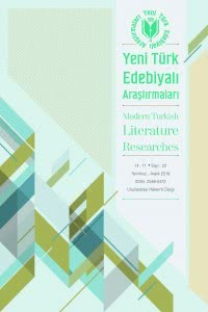HALİT ZİYA UŞAKLIGİL’İN KIRIK HAYATLAR ROMANINDA KÜLTÜREL DÖNÜŞÜM
Yazdığı romanlar bugün için dahi birçok araştırmaya konu olan ve etkisini sürdüren Halit Ziya Uşaklıgil, Batılı yaşam tarzı ve kültürel dönüşüm gibi konularda kaleme aldığı kitaplarla devrinin önde gelen figürlerinden birisidir. Gerek kurgu gerekse kurgu dışı eserlerinde “kültürel dönüşüm” meselesini farklı şekillerde gündemine alan ve çalışma- larına yansıtan Uşaklıgil için bu durum üzerinde durulması gereken temel meselelerden de birisidir. Özellikle romanlarında çeşitli vesilelerle bu konuya eğilen Uşaklıgil, belirli düşünme pratikleri etrafında Batılı yaşam tarzı ve bu tarza uygun alışkanlıkların Osman- lı toplumunda ne gibi değişiklere neden olduğunu da açıkça göstermeye çalışmıştır. Bu pratikler okura Uşaklıgil’in kişisel yaşamıyla ilgili olduğu kadar onun içerisinde bulun- duğu sosyal sınıf, parçası olduğu edebî topluluk ve entelektüel çevre ile ilgili de birçok şey söylemektedir. Şinasi’den sonra hızlanan, özellikle Edebiyat-ı Cedîde döneminde kendisine geniş bir alan bulan ve Türk edebiyatın temel sorunsallarından birisi hâline gelen bu “kültürel dönüşüm” meselesi, böylelikle Uşaklıgil edebiyatının da en temel izleklerinden birisi hâline gelmiştir. Bu makale kapsamında Halit Ziya Uşaklıgil’in Kırık Hayatlar isimli romanı “kültürel dönüşüm” konusu etrafında değerlendirilirken bu kav- ramın 20. yüzyılın ilk döneminde ne tür anlamlar ifade ettiğini üzerinde durulacak, bu meselenin Türk edebiyatında kökenini nereden aldığı gösterilmeye çalışılacaktır.
Anahtar Kelimeler:
Halit Ziya Uşaklıgil, Kırık Hayatlar, kültüren dönüşüm, Fredric Ja- meson, Hayden White, Neil Smelser.
CULTURAL TURN AT HALİT ZİYA UŞAKLIGİL’S KIRIK HAYATLAR
Halit Ziya Uşaklıgil, whose novels are the subject of many research even today, is one of the important figures of his era with the books he wrote on subjects such as Western lifestyle and cultural turn. For Uşaklıgil, who puts the issue of “cultural turn” on his agenda in different ways in both his fiction and non-fiction works and reflects on his works, this situation is one of the main issues that should be emphasized. Uşaklıgil, who has focused on this subject on various occasions, es- pecially in his novels, has tried to clearly show what kind of changes the Western lifestyle and habits suitable for this style have caused in the Ottoman society around certain thinking practices. These practices tell the reader a lot about Uşak- lıgil’s personal life as well as his social class, literary community and intellectual environment. This “cultural transformation” issue, which accelerated after Şinasi, found a wide area especially in the period of Edebiyat-ı Cedîde, and became one of the main problematics of Turkish literature, has thus been accepted as one of the most basic themes of Uşaklıgil literature. Within the scope of this article, while evaluating Halit Ziya Uşaklıgil’s novel Kırık Hayatlar around the subject of “cultural turn”, it will be focused on what kind of meanings this concept means in the first period of the 20th century, and it will be tried to show where this issue originates in Turkish literature.
Keywords:
Halit Ziya Uşaklıgil Kırık Hayatlar, cultural turn, Fredric Jameson, Ottoman society, Hayden White, Neil Smelser.,
___
- Bonnell, Victoria E.; Hunt, Lynn (1999). Beyond the Cultural Turn. Berkeley: University of California.
- Cevdet Kudret (1997). Edebiyatımızda Hikâye ve Roman, C. I. İstanbul.
- Darnton, Robert (2009). “Workers Revolt: The Great Cat Massacre of the Rue Saint-Séverin”, The Great Cat Massacre and other Episodes in French Cultural History. 75-104.
- Eyerman, Ron (2004). “Jeffrey Alexander and the Cultural Turn in Social Theory”, Thesis Eleven. No. 79.
- Jameson, Fredric (1998). The Cultural Turn: Selected Writings on the Postmodern, 1983-1998. Brooklyn: Verso.
- Necatigil, Behçet (1979). Edebiyatımızda Eserler Sözlüğü. İstanbul.
- Pierce, Craig L. (2004). “Changing Perceptions of the Ottoman Empire: The Early Centuries”, Mediterranean Historical Review. 19:1, 6-28.
- Steinmetz, George (1999). State/Culture: State-Formation after the Cultural Turn. Ithaca, NY: Cornell University.
- Uşaklıgil, Halit Ziya (2019). Kırık Hayatlar. İstanbul: Can.
- ISSN: 1308-8203
- Yayın Aralığı: Yılda 2 Sayı
- Başlangıç: 2009
- Yayıncı: Türk Edebiyatı Vakfı
Sayıdaki Diğer Makaleler
İKİNCİ DÜNYA SAVAŞINDA TÜRK-İTALYAN İLİŞKİLERİNİN TÜRK ŞİİRİNE YANSIMASI
MODERNLİĞİN NOSTALJİCİ TUTUMU: YAHYA KEMAL ŞİİRİ
ALMAN TERBİYESİ ROMANINDA KİMLİK, AİDİYET VE HUZURSUZLUK
GILGAMIŞ MİTİNİN YAPISÖKÜMÜ: ZEYNEP AVCI’NIN GILGAMIŞ ADLI OYUNU
MUSTAFA KUTLU’NUN TAHİR SAMİ BEY’İN ÖZEL HAYATIHİKÂYESİNİN METİNSEL ARKA PLANI
HALİT ZİYA UŞAKLIGİL’İN KIRIK HAYATLAR ROMANINDA KÜLTÜREL DÖNÜŞÜM
AHMET MİTHAT EFENDİ JÖN TÜRK ROMANINI NEDEN YAZDI?
